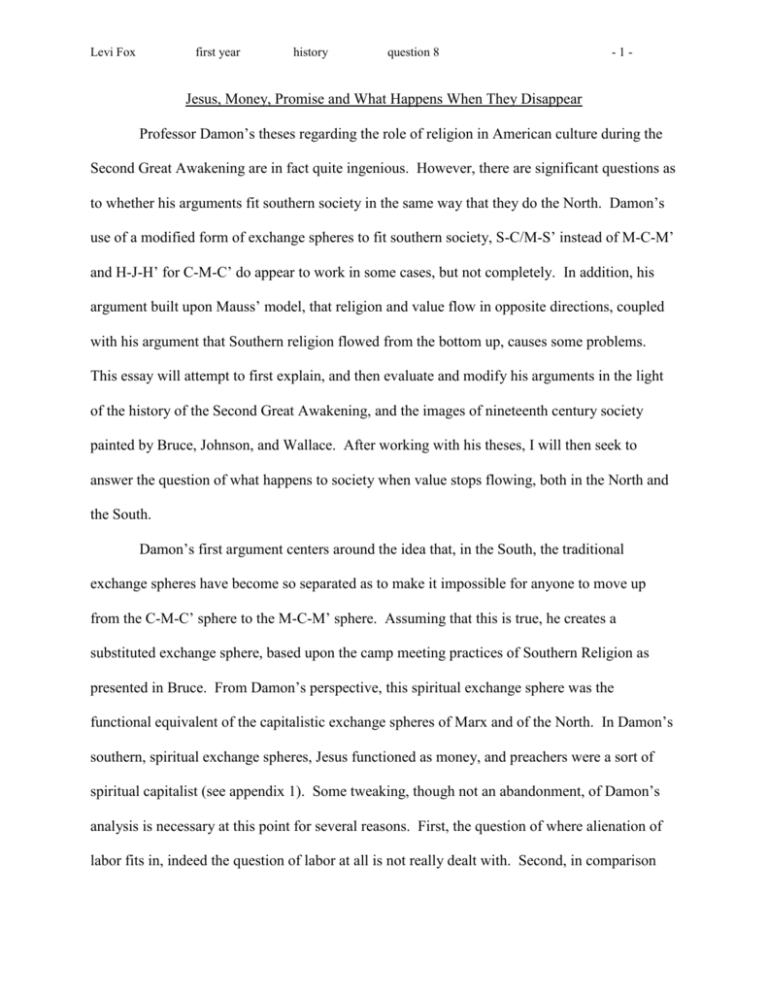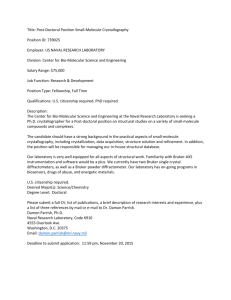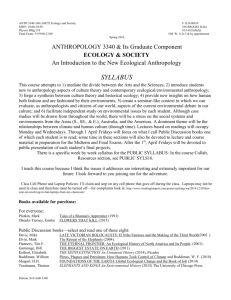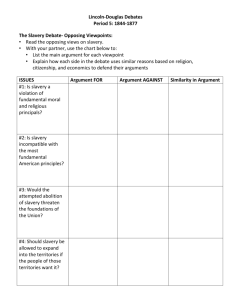Levi Fox first year history question 8
advertisement

Levi Fox first year history question 8 -1- Jesus, Money, Promise and What Happens When They Disappear Professor Damon’s theses regarding the role of religion in American culture during the Second Great Awakening are in fact quite ingenious. However, there are significant questions as to whether his arguments fit southern society in the same way that they do the North. Damon’s use of a modified form of exchange spheres to fit southern society, S-C/M-S’ instead of M-C-M’ and H-J-H’ for C-M-C’ do appear to work in some cases, but not completely. In addition, his argument built upon Mauss’ model, that religion and value flow in opposite directions, coupled with his argument that Southern religion flowed from the bottom up, causes some problems. This essay will attempt to first explain, and then evaluate and modify his arguments in the light of the history of the Second Great Awakening, and the images of nineteenth century society painted by Bruce, Johnson, and Wallace. After working with his theses, I will then seek to answer the question of what happens to society when value stops flowing, both in the North and the South. Damon’s first argument centers around the idea that, in the South, the traditional exchange spheres have become so separated as to make it impossible for anyone to move up from the C-M-C’ sphere to the M-C-M’ sphere. Assuming that this is true, he creates a substituted exchange sphere, based upon the camp meeting practices of Southern Religion as presented in Bruce. From Damon’s perspective, this spiritual exchange sphere was the functional equivalent of the capitalistic exchange spheres of Marx and of the North. In Damon’s southern, spiritual exchange spheres, Jesus functioned as money, and preachers were a sort of spiritual capitalist (see appendix 1). Some tweaking, though not an abandonment, of Damon’s analysis is necessary at this point for several reasons. First, the question of where alienation of labor fits in, indeed the question of labor at all is not really dealt with. Second, in comparison Levi Fox first year history question 8 -2- with the Marxian exchange spheres, those in the South don’t correspond completely. For example, the S, saints, is not exchanged for H, hell, in the same way that money is exchanged for commodity labor. Damon’s analyses have the upper, quantitative exchange sphere consisting of Saints using a camp meeting to produce more Saints. This sphere functions perfectly well. The problem is with the lower sphere and its relations to the upper sphere. It is at this point that we must consider the institution of slavery and its affect upon the Southern view of people. If we assume that slavery permits people to be viewed as commodities, as well as the owners of commodities, the model becomes clearer, but also separated from Marx’s model. In the revised model (see appendix 1) the separation between the two spheres collapses. Yet the basis for the spheres is maintained. Saints (the converted especially preachers and assuming, as they did, that all converted would help to spread the word) must be viewed as both spiritual capitalists and as the product of the application of Jesus to sinners. The Jesus in this case does not function so much as money but as what could be called entrepreneurial capital, which is the functional equivalent of a factory in that it need not be diminished by use or purchased by the capitalist for each round of the exchange spheres. In this model the existing saints can apply their Jesus repeatedly to sinners, thus adding value to the sinners and converting them into saints. The transformation from sinner to saint in this case is a qualitative measure as well as a quantitative measure, since it both increases the number of saints, who can then use their Jesus to create even more saints and changes the individual sinners. With people functioning as both commodities and the owners of commodities, the functionality of this model becomes clear. The sinners own only themselves, and give freely of themselves to the spiritual capitalists in order to have value added to themselves and become Saints. This draws an interesting parallel with the northern worker in Johnson who commented that he made more money because he had gotten religion. Levi Fox first year history question 8 -3- For the parallel to work between Northern Capitalism and Southern Religion some aspect of Sainthood must be regarded as money as well as commodity. In this case the model starts to look more like Marx’s (see appendix 2). From the perspective of the sinner (worker?) he exchanges himself (his labor?) for sainthood, which now takes on the functionality of money. Viewing sainthood as money, Damon’s conjecture that Jesus functioned as money is given new validity, as Jesus is an integral part of Sainthood. The sinner, who for our purposes now owns his sainthood, and exchanges that for the commodity of Saint, which he now becomes. The system works only if people themselves (and not their labor) can be viewed as commodities, which can work in the South given the existence of slavery. This revised view of Damon’s theses also works well towards solving the problem of alienation, or the complete lack of any mention of it. In such a system it is not that alienation does not exist, but that it cannot. Using the analogy of a sinner as the commodity traded for sainthood with that of labor as a commodity traded for money, we see that the commodity traded for the equivalent of money is exactly the same as the person who does the trading. Thus, while workers can feel alienated from their labor when it is sold to capitalists, the fact that sinners are able to continue to view themselves as free, this time because of the contrast between slaves and free men provided by slavery, makes it impossible to be alienated from themselves. They continue to own themselves. Furthermore, they will receive at least some of the value from the quantitative creation of more saints in that they themselves will now be a saint and will henceforth be able to function in the upper, capitalistic Saint-Camp Meeting-Saint’ (or revised St-Sn+J-St’) sphere. In many ways the second aspect of Damon’s theses concerning religion during the Second Great Awakening is even more problematic. Based upon Mauss, he presents a system whereby value and spirituality flow in different directions. Running with this, he argues that in Levi Fox first year history question 8 -4- the North religion flowed from the top of society down, while value flowed from the bottom up (see appendix 2). The upper echelons knew that it was the working classes who were creating enormous amounts of value, which they were then appropriating. According to Damon, they then sought to return something to the lower classes, namely religion. This model works beautifully in the north, where Marxian economics tells us that value was created by the labor power of the workers and where Johnson tells us the religion was promulgated by the upper classes. He says that “the most powerful source of the workingman’s revival was the simple coercive fact that wage earners worked for men who insisted on seeing them in church” (Johnson p121). Whether workingmen viewed religion as a just compensation (or whether they viewed it, and especially the temperance and lost leisure time that accompanied it, as a burden) is further brought into question by the words of a worker who said “I don’t give a damn (about religion). I get give dollars more in a month than before I got religion” (quoted in Johnson p121). Indeed it seems that Johnson would tend to view the upper classes as utilizing religion more “as a crucial step in the legitimization of free labor” (Johnson p141) than as a “gift” of the upper classes lower classes. Yet, completely apart from Johnson’s analysis and from the appearance of this system to later historians or even to the workers of the time, there is no reason to doubt that the capitalists of the time felt that their religion served to return something to the lower classes. Furthermore, this mindset would fit with the argument that in the North, the upper classes had become separated from those below, in that their attempts to force their workers to become the same religion as they were would serve to unify the groups again. Thus, with regard to the North, Damon’s theses seem to work fine. The major problem with the model begins when one tries to apply it to the South, where Bruce tells us that religion was promulgated by the lower groups in society. In order for this Levi Fox first year history question 8 -5- model to work the upper rung of society in the South would have to be passing value down to the lower social groups. This does not appear true, at least not in the way that the workers in the North created value for the capitalists. While one possible way of answering this question, and a bit of a cop out, is to say that the North and South were so fundamentally different that the model cannot and need not apply to the South. This idea is predicated partly upon the notion that the South was a much more status-like society than the North, with the domination in the South being personal as opposed to abstract. While this may to a certain extent be true, it is far from a complete explanation of why the model should not work. Damon’s explanation is that Southern Camp meeting religion was a response to the Honor Code which was promulgated by the planter elite. While this is completely possible, and would serve as some sort of transfer from the upper classes to lower classes, there does not seem to be a correspondence between a code of conduct and value. Furthermore, since in the North it was the group (the capitalists) which had been become separated from its social opposites that first put forth a method of reunification, it would seem unlikely that that in the South, where the lower classes were the group which had become separated, for their religious attempts at reunification to have been a response to anything. Thus, it would seem that the use of the honor code as reciprocation for religion leaves much to be desired. But perhaps most importantly, I don’t see there being any real need to substitute honor for value, since Damon’s model for the North can be made to work in the South if we consider the historical economics and politics of the that region during this time. (****Though arguable, the model about to be constructed does seem to correspond with the notion of value and spirituality flowing in opposite directions, and further will allow for interesting conjecture with regards to the question of what happens when value stops moving in the system.****) In the North, the upper classes “gave” religion to the lower classes as a way of repaying them for the Levi Fox first year history question 8 -6- value they gave to the capitalists, thus creating some sort of reciprocity between the classes. Therefore, unless the Southern planter class was extremely greedy, it seems unlikely that the lower class could have provided both value and religion to the upper classes and received nothing in return, status society or not. In actuality, the lower classes of the south did not supply value to the upper classes and they did receive something analogous to value from the planters. The upper class was able to be an upper class without extracting value from the plain folk because of the institution of black slavery. Slavery changed the entire exchange sphere system, creating a system which could not be covered by conventional Marxian categories. Owning both the means of production and the labor which was applied to it, the southern planter operated wholly in the M-C-M’ sphere, never needing to make use of the C-M-C’ sphere. (****Incidentally, this fact seems to me proof or at the very least a sufficient explanation of why the lower class in the south was separated from the upper class. Furthermore, while the timing thing, i.e. why this could be viewed as a change originally gave me problems, but the fact that the cotton gin was invented in the 1790s and that cotton growing in the old southwest only got going during the 1810’s , coupled with the fact that this is the region where camp meeting religion took hold seems to provide a fitting answer****). Thus the southern upper class was not receiving the best of both worlds so to speak because it didn’t need the labor the of lower classes and the value which it creates, but was receiving only religion from below. Still, accepting for the moment the validity of Damon’s theses, it would seem unlikely that the upper classes were receiving religion without the lower classes being in some way compensated. And, following the model (though in contrast to his own explanation of the role of the Honor Code), it would seem that this compensation must consist of some sort of value, or at least of something analogous to value. Indeed what the planters compensated the plain folk with was potential to acquire value, Levi Fox first year history question 8 -7- which was preserved through political means. This opportunity for future value, given the way in which value was created in the South, again relates to slavery, this time to the opportunity for plain folk to someday become planters. While not a common occurrence, people could and did move up socially and economically into the planter class. And the plain folks knew this. They kept up the hope of socio-economic mobility and of being on the receiving end of value. “ Even though the small farmer occupied a marginal position within the South, he had reason to believe in the possibility of his upward movement within the system” (Bruce p19). The planters in a sense “gave” this hope of value to the lower class by simply existing as a social class. But more than that, they worked politically to provide the means for social mobility by working for the westward extension of slavery. This possibility of social mobility would be severely weakened if slavery were prevented from expanding and providing new lands for a new class of planters to operate. This desire to return something to the lower classes, or more likely a sense that this must be done in order to secure their social position, at least in part explains the political intransigence of Southern politicians (who largely represented the planter class) with regard to the slavery extension issue. Thus what the lower classes got in exchange for their religion, and in keeping with Damon’s model, though not a form of value was the possibility of receiving value in the future, and of someday operating in the planter’s sphere. Based upon the models of economic and spiritual flows we now turn to the question of what happens when value stops flowing. The answer to this question (at least with regard to the north) is presented in St. Clair. Do to the geologic realities of the area, once the initial mines were exhausted, it was impossible for deeper mines to be run profitably. Thus, while money was made during the 1850’s and 60’s while the shallow mines were still productive, during the 1870’s enormous sums were lost by the mine owners. Interestingly, this change in value Levi Fox first year history question 8 -8- corresponds to a shift in the Kondratieff long wave cycle, yet the possibility of any connection between these two events will not be explored at this point, since it need not be to show the effects on St. Clair of such a stoppage of value going upward. However, on a larger scale, this shift in Kondratieff waves also corresponds to growing labor unrest and employer repression throughout this period. In the case of St. Clair we are presented with a correspondence between the cessation of rising value and the Molly Maguire showcase trials. Between 1875 and 1884 the “Twin Shafts (new deep mines at St. Clair), which had been expected to produce 750,000 tons of coal a year indefinitely , shipped a total of only 275,871 tons.” (Wallace p. 435). The question of where value was going, or more importantly where the capitalists thought that value was going since it quite obviously was not flowing upward, comes into play when we look at the showcase trial of 1875. The rhetoric of the prosecution indicated, at least in retrospect, that value was being lost due to the actions of the Molly Maguires. Their harsh indictment of the Molly Maguires including the statement that “never since the world began has there existed a more villainous society or more horrible organization than “ the Mollys. (Wallace p357). Thus the capitalists sought (like they had done previously in cases when mine accidents had caused value to be lost) to place the blame squarely on their workers, as represented by the Mollys. An additional reason for the vehemence of these attacks stems from what happens to religion when value stops going upward. Given the nature of the flow system, religion could not flow down in the absence of upward flowing value. And with value flowing negatively it follows that the Capitalists could have seen religion flowing that way was as well. Thusly, the cessation of value flow (or what they viewed as the seepage of value due to actions of the workers) would have cause a cessation of religion or even a descent from religion. By extension, the actions of the workers could have been viewed a movement toward hell. Thus for both their economic self Levi Fox first year history question 8 -9- interest, and especially for what they may perceive as happening to religion when value stops flowing, we get the violent rhetoric of the showcase trial as well as general enmity of capitalist towards worker that would result in bloody incidents between workers and Pinkerton guards during this era. So what happens to the South when value (or in this case the promise of value) ceases to flow. It has already been argued that the planter elite in the South worked to extend slavery westward partly as a way of returning some form of value to the lower class which had supplied them with religion (though the acceptance of religion by elite southerners, much like by northern workers, may have been based more upon social necessity than religious fervor). But while the stoppage of value flow in the North came during the 1870s due to structural reasons and Kondratieff troughs (both in St. Clair and in the region as whole), the cessation of flow in the South was a political event. This event occurred in 1860, with the election of a president who was sworn to prevent all westward expansion of slavery. Whether the lower classes viewed this cessation of value flow as resulting in a cessation of spiritual flow is not discernible, but what is clear is that they made up the majority of the Confederate army during the Civil War. Because there was a political, rather than economic, reason for the stoppage of flow in the South (since the 1860 was right in the middle of a Kondratieff upswing) the lower classes did not attack their own elite, but rather Northerners who had caused the flow to stop. (****This explanation ties in well with another of Damon’s arguments, that the South as whole served as economic producers for the North. However, further exploration of this intriguing point necessitates study into the relationship between Northern and Southern religion, as well as subsequent study of overall value flow, and is far beyond the scope of this paper.****) Thusly, though a bit of a stretch, the Civil War can be viewed as a response to the cessation of value flow in the South. Levi Fox first year history question 8 - 10 - Overall, Professor Damon’s various theses hold up well under scrutiny. His arguments relating to the place of religion in the North (viewing it as a way of returning something to the lower classes in exchange for value) seems rather solid. His arguments concerning the structure of southern religion as being analogous to Northern Capitalism also seem to be workable, though some manipulation of the model is necessary in order to institute a better correspondence with Marx’s model. Furthermore Damon’s value/religion flow model works impeccably in the North, and quite feasibly in the South if, instead of using the honor code as a southern counterpart to value, we look at the promise of value through slavery expansion. Thus two things can be said. First, Damon’s models do in fact seem to apply to the South, and second that they must be applied at all times with a view of the importance of slavery. In order to understand southern society, and religious structures, and thus to successfully apply Damon’s models to them, the institution of slavery cannot be overlooked.











